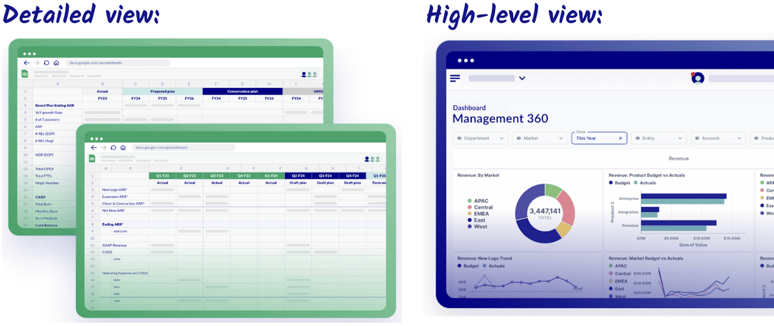Christina Ross (CEO of Cube) teamed up with Chris Ortega (CEO of Fresh FP&A) for an info-packed webinar to discuss proven tactics for surviving budget season.
Check out highlights from the webinar below.
Product

Product
Why Cube?
Cube is the only FP&A platform that lets you use your existing spreadsheets and models.
AI in Cube
Cube’s AI automates the heavy lifting, letting your finance team focus on strategic insights.
How Cube works
Sync data, gain insights, and analyze performance right in Excel, Google Sheets, or the Cube platform.
Developer Center
Cube's API empowers teams to connect and transform their data seamlessly.
Integrations
Connect and map data from your tech stack, including your ERP, CRM, HRIS, business intelligence, and more.
Security
Built with world-class security and controls from day one.

Get a demo
Break free from clunky financial analysis tools. Say hello to a flexible, scalable FP&A solution.
See Cube in action
Use Cases

Use Cases
Data Management
Reporting & Analytics
Reporting & Analytics
Easily collaborate with stakeholders, build reports and dashboards with greater flexibility, and keep everyone on the same page.
Three statement model Cash flow reporting Ad-hoc reporting Performance reporting Variance analysisPlanning & Modeling
Planning & Modeling
Accelerate your planning cycle time and budgeting process to be prepared for what's next.
Annual planning Headcount planning Forecasting Driver-based planningStrategic Finance
.png)
Creating a high-impact finance function
Get secrets from 7 leading finance experts.
Download the ebook
Industries

Resources

Company

Company
About us
We're on a mission to help every company hit their numbers. Learn more about our values, culture, and the Cube team.
Careers
Grow your career at Cube. Check out open roles and be part of the team driving the future of FP&A.
Contact
Got questions or feedback for Cube? Reach out and let's chat.
In the news
Curious what we're up to? Check out the latest announcements, news, and stories here.

A newsletter for finance—by finance
Sign up for our bi-weekly newsletter from 3x serial CFO turned CEO of Cube, Christina Ross.
Subscribe now
4 proven tactics to survive budget season for finance leaders (video included!)
Updated: September 22, 2023 |
Christina Ross
CEO & Co-Founder, Cube Software
Cube's founder and CEO, Christina Ross is a 3x CFO and former finance transformation leader. As a well-recognized finance expert in all things FP&A, she is passionately mission-driven to help finance leaders become the heroes of every org. She currently resides in NYC.
CEO & Co-Founder, Cube Software
Contents
Sign up for our bi-weekly newsletter from serial CFO and CEO of Cube, Christina Ross.
As a former 3x CFO, I've survived my fair share of budget seasons—and so has my colleague, Chris Ortega (fractional CFO and CEO of Fresh FP&A).
From budget season horror stories to tales of success, Chris and I discussed it all in our recent webinar, Surviving Budget Season: 4 Proven Tactics for Finance Leaders. We spilled our tricks of the trade and offered our best advice to ensure your upcoming budget season is productive, collaborative, and on target.
If you couldn't make it live, check out some of the highlights below for quick tips to help you prep for this crucial time of year.
Before you can work the plan, you've got to plan the work. In my experience, there's no better way to do this than by creating a comprehensive financial planning calendar.
To create an effective calendar, be sure to:
When presenting a financial plan, it's crucial to consider your audience. For top-level executives and the C-suite, they often prefer a high-level overview; they want the key takeaways without getting bogged down by details like accruals and variances.
On the other hand, for those delving deeper into finances, a more detailed framework can be helpful. This can involve breakdowns by department, key drivers, or different scenarios.
This is where technology can be a game-changer. With FP&A software, you can streamline communication and simplify the tracking and reporting processes during budgeting. With the right tech, both granular views (like the ones on the left) and comprehensive snapshots (like the one on the right) can be efficiently presented, catering to diverse audience needs.

The right software can make the planning process faster and more efficient. The main thing? Focus on solving real pain points, like consolidating and unifying data. Many finance leaders say that's their biggest challenge. But it's not just about data; it's also about collaborating effectively and scaling up as the business grows.
Here's a glimpse into how software and consultation can truly accelerate (and improve) the planning process:

When rolling out a budget, you'll inevitably hit some bumps in the road. But there are four things you can consciously avoid doing to make the process smoother:
We've only scratched the surface with these tips. Want to learn more?
Click the image or button below to view and download the on-demand recording.

View the recording